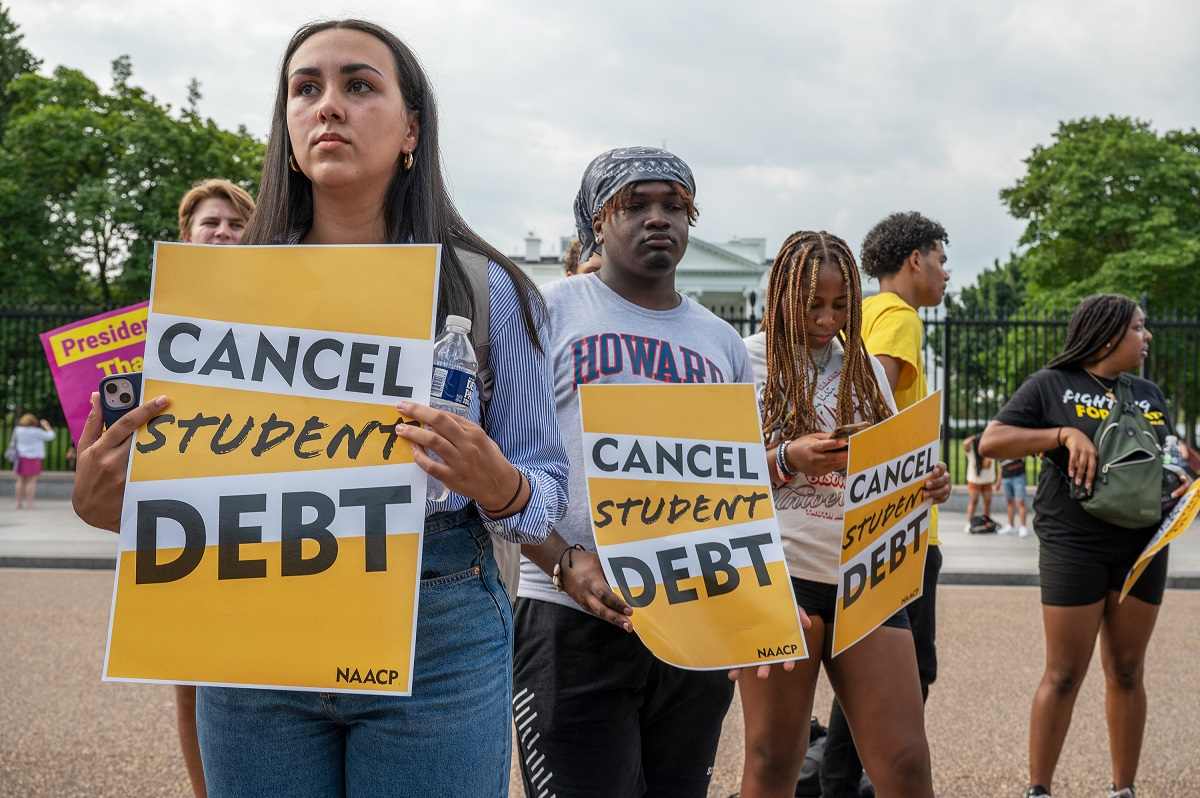
Sabrina Calazans, director of borrower outreach at Student Debt Crisis Center, and Howard University students Aiden Thompson and Sydney Stokes, rally with other student loan debt activists outside the White House on Aug. 25, 2022.
12:02 JST, January 28, 2023
The Biden administration on Friday released a state-by-state breakdown of people who could get assistance from the president’s embattled student-loan debt relief program, days after the Education Department said independent auditors had questioned the estimated cost of the effort.
Officials say 26 million people had applied or were automatically deemed eligible to have up to $20,000 of their federal student loans canceled before an appeals court imposed a nationwide injunction halting the relief plan. The department has approved 16 million applications, assuring borrowers that the administration will discharge the debt if it prevails in court.
The most populous states had the highest numbers of applicants and automatically eligible people, with California leading the pack with 2.3 million people, followed by Texas with 2.1 million, the data shows. Wyoming and Alaska had the fewest, with 30,000 and 38,000 respectively.
Next month, the Supreme Court will hear oral arguments in two cases seeking to overturn the debt relief policy that conservatives have panned as an expensive giveaway and executive overreach.
Speaking to reporters Thursday, Bharat Ramamurti, the deputy director of the White House National Economic Council, defended Biden’s forgiveness policy as a way to protect those most at risk of falling behind on their loans when the pause on student loan repayment ends.
“This action … will help ensure that those working- and middle-class borrowers are not made worse off with respect to their loans because of the COVID-19 national emergency,” Ramamurti said. “Only because of Republican officials and special interests’ flawed legal campaign, millions of eligible borrowers are being denied the relief that they need.”
In one of the two lawsuits headed to the Supreme Court, Republican attorneys general and officials of Nebraska, Missouri, Arkansas, Iowa, Kansas and South Carolina have accused the president of overstepping his authority and threatening the revenue of state entities that profit from federal student loans. In the other, a pair of Texas borrowers, one who does not qualify for the full $20,000 in debt relief and one who is ineligible altogether, are at the heart of the other lawsuit heading to the Supreme Court.
Jordan Matsudaira, the Education Department’s deputy undersecretary and chief economist, said officials’ attempt to derail the policy is coming at the expense of their own constituents. For example, Matsudaira noted that more than 480,000 people in Missouri have applied for relief.
“Our new data shows we sent instructions to servicers to discharge debt for 305,000 of these borrowers but were forced to stop because of the lawsuit,” Matsudaira said on a call with reporters Thursday. “Elected officials and special interests are playing politics with the lives of 26 million borrowers across America.”
The department has previously said that more than 40 million borrowers could be eligible for forgiveness, though people could opt out of the relief.
The state-by-state breakdown arrives days after the Education Department released its annual report, in which auditor KPMG raised concerns with how the agency calculated the cost of the debt relief policy. The firm, which was hired by the department’s inspector general for the annual audit, said the department was “unable to provide adequate evidential matter to support certain key assumptions” used to determine the price tag.
In September, the department estimated the one-time debt relief program would cost $379 billion throughout a period of over 30 years and reduce cash flow to the agency by $305 billion over the next decade. The estimates were based on the assumption that about 81 percent of eligible borrowers would take advantage of the program, but the agency said at the time that the estimates were based on “highly uncertain assumptions.” By comparison, the Congressional Budget Office estimated the program would cost $400 billion over 30 years based on a takeup rate of 90 percent.
KPMG expressed concern with how the department estimated the number of borrowers who will participate, saying an undercount could drive up the cost. The firm said the agency’s approach was “not properly designed,” a charge the department disputes.
An Education Department spokesman said Thursday, “The initial assumptions were based on information available at the time that was applied to a new program that had not yet launched.” The department stopped accepting applications in November because of the ongoing court challenges and said it has not been able to use concrete application data to demonstrate the accuracy of its estimates.
All the same, Rep. Virginia Foxx (R-N.C.), the chairwoman of the House Education Committee, pounced on the report, saying it shows “the department is blatantly lying about how much taxpayer money it is giving away.” She said the department essentially made up the figures and can’t defend them to its auditor, a claim the department denies.
"News Services" POPULAR ARTICLE
-

American Playwright Jeremy O. Harris Arrested in Japan on Alleged Drug Smuggling
-

Japan’s Nikkei Stock Average as JGB Yields, Yen Rise on Rate-Hike Bets
-

Japan’s Nikkei Stock Average Licks Wounds after Selloff Sparked by BOJ Hike Bets (UPDATE 1)
-

Japan’s Nikkei Stock Average Buoyed by Stable Yen; SoftBank’s Slide Caps Gains (UPDATE 1)
-

Japanese Bond Yields Zoom, Stocks Slide as Rate Hike Looms
JN ACCESS RANKING
-

Keidanren Chairman Yoshinobu Tsutsui Visits Kashiwazaki-Kariwa Nuclear Power Plant; Inspects New Emergency Safety System
-

Imports of Rare Earths from China Facing Delays, May Be Caused by Deterioration of Japan-China Relations
-

University of Tokyo Professor Discusses Japanese Economic Security in Interview Ahead of Forum
-

Tokyo Economic Security Forum to Hold Inaugural Meeting Amid Tense Global Environment
-

Japan Pulls out of Vietnam Nuclear Project, Complicating Hanoi’s Power Plans






















